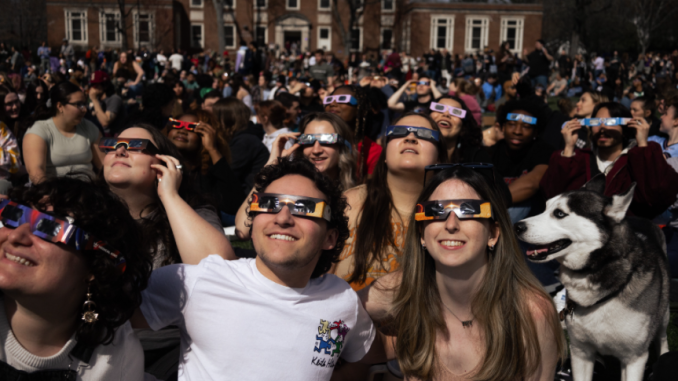
On April 8, at approximately 3:28 p.m., New Paltz witnessed the peak of the total solar eclipse at 94% totality. Over a thousand students, faculty and others gathered around Old Main Quad to watch as the moon moved directly between the Earth and the sun. This was the first time since 1925 that New York was in the path of totality.
With live music and an array of telescopes with solar filters lined down Old Main Quad, the years of planning put into the event was made abundantly clear. According to University Spokesperson Andrew Bruso, credit for the event goes to John R. Kirk Planetarium Director Raj Pandya and his team of students, faculty and partners from the Mid-Hudson Astronomical Association. Pandya, who is also a lecturer with the Department of Physics and Astronomy, has been planning the event since the end of the partial solar eclipse that took place seven years ago. “I’ve been looking forward to this since 2017,” said Pandya. “I knew the next one was going to be today, April 8, 2024, so I kind of had the idea in my mind for the last seven years. This actual event on the quad, I’ve been planning for the last one or two years.”
Pandya, who has been studying astronomy for 15 years and teaching at New Paltz for 13, held a preview event of the solar eclipse on April 3, opening up a discussion to the public in Science Hall 181. The Oracle previously reported on the event where Pandya discussed the science behind eclipses and the best way to prepare for the upcoming one.
Planning for the event meant ordering as many eclipse glasses as possible, reserving the quad and making sure there were enough volunteers to help out. Volunteers, like first-year biochemistry major Janiah Torres, were responsible for setting up the solar telescopes and watching over the use of them by the public. While the university already had most of the telescopes in preparation for this event, Pandya had been purchasing more. This included solar filters to go on the telescopes.
Torres recounts receiving an email from the AC2 Program prompting students to sign up to be volunteers. Torres had never worked with the equipment before, but was able to seamlessly pick it up after a one hour training session held on April 7 between 3-4 p.m. The following day, volunteers started to pack the telescopes at around 11:00a.m., they were successfully brought to the quad by 11:30 am and finished setting up around an hour later.
Torres was prepared for a crowd of about a thousand individuals. She stated how it felt like more than that and, despite the initial overwhelming feeling, she was excited to meet new people and be able to show them the eclipse from such a close distance.
“I feel like the turnout is great. I’m really happy to see so many people,” said Pandya looking out into the crowd — a sentiment that was carried throughout New Paltz. Despite the excitement of the eclipse, President Wheeler reminded The Oracle that, “The eclipse is going to occur, but the fact that we are doing this together — that makes it a SUNY New Paltz moment.”
The eclipse was set to begin at 2:11 p.m. in New Paltz, however, those planning to attend the event were asked to arrive around 1:45 p.m. Mid-eclipse was expected at 3:25 p.m. and the eclipse ended at 4:36 p.m. Several emails were sent to students, many of which were posted on the SUNY New Paltz website. The office of Environmental Health and Safety sent an email to all students on April 2, listing out ways to safely view the eclipse, prompting students to not view the sun through a camera lens while wearing eclipse glasses and providing information on when it was safe to look straight at the sun during the eclipse. The email also provided a map of the path of totality in New York State with time stamps for when the eclipse was to begin, peak and end, as well as links for those interested in the indirect viewing method, an alternative to eclipse glasses.
Esopus resident Brian Sechler and his family sat on the quad excited to witness the eclipse with box pinhole projectors in hand. Sechler, along with his mother, wife and three kids decided that New Paltz would be the perfect place to watch the eclipse. Aside from his children going to school in town and his mother living nearby, the Sechler family has been attending events in the planetarium. Knowing that telescopes would be available and that his children have already enjoyed the planetarium regularly, it only made sense to watch the eclipse in New Paltz.
Referred to as an amateur astronomer by her husband, Alexandra Sechler enjoys teaching her kids about all that astronomy has to offer, even sitting down with them to build pinhole projectors to view the eclipse out of. “It’s just a great way for us to celebrate our love of the natural world, and to show the kids how much everyone else appreciates it as well. And to take advantage of the fantastic community services that the university has to offer,” said Sechler.
“This one-of-a-kind event demonstrates an important role that New Paltz plays as a public university: serving as a gathering place where people from around the region can learn new things and share unique experiences. It was a really nice mix of students, faculty, staff, retirees, families and visitors from the community, and we’re glad so many people were able to come out and make our campus part of their 2024 solar eclipse story,” added Bruso.
Reporting done in collaboration with Alison Aaron and Nicole Pottgen.

